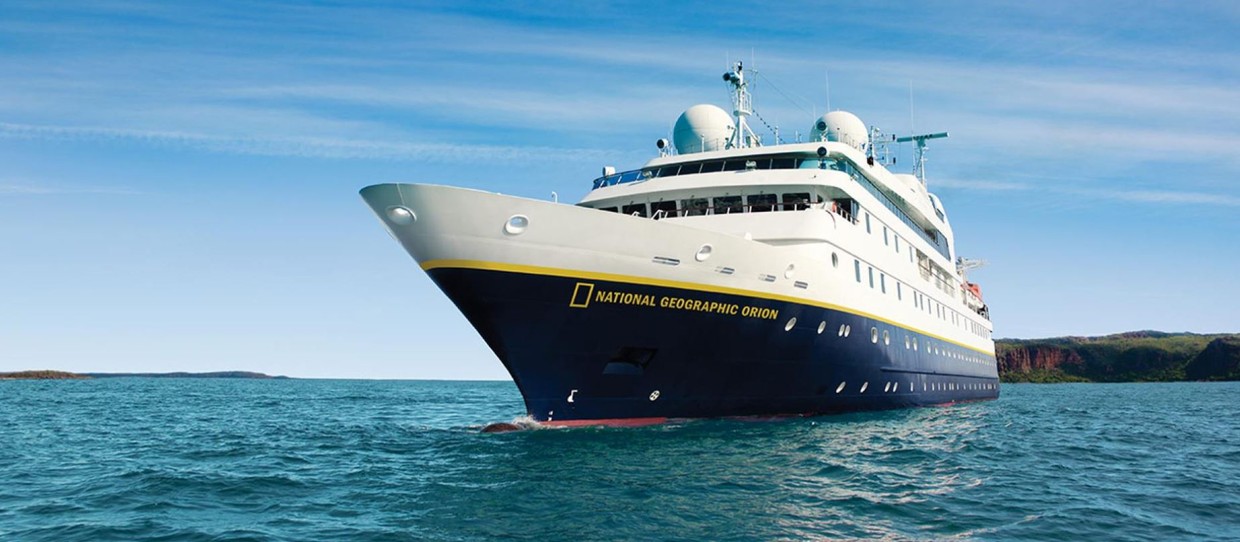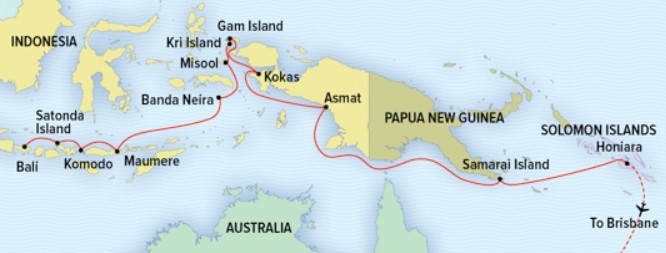2022-02-25
2025-01-01
Note: Current p/p indicative rate. Final price may change due to currency fluctuations.
Set sail from Bali on an expedition to discover Indonesia’s rich tapestry of cultures and lush tropical islands. Experience the thrill of spotting rare Komodo dragons in the wild; snorkel and dive at pristine coral reefs of the Moluccas, Raja Ampat, and West Papua; take part in exuberant welcome ceremonies at the secluded villages we’ll explore along the way; and step back in time as we learn about some of the fiercest battles of the Pacific Theater during World War II. Explore the fascinating riverine world of the Asmat region, one of the least-explored places on Earth, as the National Geographic Orion makes her way to the Solomon Islands.
Arrive in Bali. Check in to the Fairmont Hotel (or similar). Meet your fellow travelers this evening at our welcome reception. (D)
This morning we check out of the hotel and head off into the countryside and the artist’s town of Ubud—famous for silver working, wood carving, and batik. As we wind our way up into the hills, we’ll pass exquisite Hindu temples, lush forests, small villages, and the terraced rice fields cut into the cliffs. From water buffalo, to ducks, to harvest, learn how all the pieces of rice production flow together and nothing is wasted. Following lunch and free time to wander through the galleries in Ubud, we’ll head back to Benoa where we embark the National Geographic Orion. (B,L,D)
Our first stop is the uninhabited Indonesian island of Satonda – a small circular island that is an ancient volcanic cone. Spend the morning snorkeling or diving the vibrant reefs or hike inland to the island’s sacred lake. This afternoon visit the island of Sumbawa, where villagers welcome us with a lively cultural display. Witness a traditional wedding ceremony and a local boxing match. (B,L,D)
Explore Komodo National Park, home to the world’s largest living lizard—the Komodo dragon. Learn about the conservation of these prehistoric giants from park rangers, who will join us on a hike to spot the lizards in their natural habitat. Then enjoy an afternoon of swimming, snorkeling, or beachcombing at “Pink Beach,” named for the coral fragments that lend their color to the sand. (B,L,D)
Flores was once an important Portuguese trading center for sandalwood. Known for producing some of the finest ikat weaving in the world, we’ll meet the people of this arid island when we travel inland from Maumere to the weaving village of Watublapi. Whereas many other local weaving communities switched to industrially spun yarn and chemical dyes for the sake of saving time and money, the weavers of Watublapi still use the traditional, handspun yarn made out of local cotton, as well as local natural dyes. We’ll also see a cultural dance presentation. (B,L,D)
Sail into the Molucca archipelago, also known as Maluku or the Spice Islands. In the heart of the Moluccas lay the Banda Islands, where a kora kora, or traditional war canoe, escorts us to the enchanted isle of Pulau Naira. Neighboring Banda Neira was once the center of the Spice Island trade and a hub of the Dutch East India Company. Stroll past Dutch architecture and visit Fort Belgica, built to protect the profitable spice trade. Next to Bandanaira, the near perfect conical volcano of Banda Api will be visible, quietly steaming away, and the crystal-clear waters provide us with some great swimming and snorkeling. (B,L,D)
Snorkel and dive one of the richest and most intricate marine regions in the world. Explore the steep coral walls and drop offs that are brimming with amazing life – colorful corals, giant clams and literally hundreds of different fish species. Above sea level, the experiences are just as amazing, with lush islands, towering limestone pinnacles jutting out of the water, and hidden white-sand coves to discover by Zodiac or kayak. On Gam Island birders may join a pre-dawn nature walk to try to catch a glimpse of the ethereal red bird-ofparadise. (B,L,D)
Soaring mountains, pristine rain forest, and dozens of the most ancient, primal tribes on the planet can be found on this amazing section of Indonesia. Use Zodiacs to get up close to 20,000- year-old rock art near the fishing village of Kokas. Explore the fascinating skull caves and rock art of the Macassan culture. See the remains of the secret underground Japanese bunkers built here during World War II. Witness the traditional gabagaba, or stick dance, and learn about the myriad cultures that have passed through this region. (B,L,D)
Arrive in the enchanting Asmat region, which spreads across mud flats and mangrove forests, with raised wooden boardwalks linking one village to the next. Elaborately painted “warriors” escort us to one of the stilt villages on shore, where we’ll attend a fascinating welcome ceremony. Our subsequent exploration will be dictated by the tides, as we venture to neighboring villages by Zodiac and encounter the ancient culture of the Asmat people, who are renowned for their woodcarving. (B,L,D)
We leave the Asmat region and sail through the Aru and Arafura Seas. During the last ice age, when sea levels were over 100 meters lower than they are today, this region was a land bridge between Australia and New Guinea. We transit the shallow, island-strewn Torres Strait, which separates Australia from New Guinea, to enter the Gulf of Papua. We’ll explore the coast and scattered islands looking for that perfect place to spend some time on a deserted beach or snorkeling through a reef bursting with color and life. (B,L,D)
It’s hard to imagine today that Samarai Island was once a bustling trading port and the second largest city in Papua New Guinea. The town was evacuated at the onset of the Pacific War and many of its buildings deliberately destroyed. When the war ended, Samarai never regained its earlier importance. Life is much slower paced nowadays, and we’ll have a chance to meet and be greeted by the town’s residents. As we depart, be sure to be out on deck as the ship cruises through the beautiful neighboring islands.
Our expedition concludes in Honiara, a former U.S. supply depot and a strategic WWII battleground. Tour around the outskirts of the city to see sites well known from the Battle of Guadalcanal in 1942-43. See the shores of Red Beach and the vital airbase at Henderson Field. Visit the hills above Honiara where some of the fiercest battles took place. Then, transfer to the airport for our flight to Brisbane, where we will overnight at a local hotel. (B,L)
Depart this morning for your flight home. (B)
Itineraries are subject to change.

Vessel Type: Luxury Expedition Length: 103 metres Passenger Capacity: 102 (in 53 cabins) Built: 2003 / Refurbished 2014 Engineered for maximum comfort and safety, Orion is equipped with the latest technology including large retractable stabilizers, sonar, radar, and an ice-strengthened hull. A shallow draft plus bow and stern thrusters provide the convenience of being able to maneuver close to shore. 14 Zodiacs ensure quick disembarkation and offer the ideal transport for up-close exploration. National Geographic Orion meets strict specifications for environmental protection and the on board waste management systems meet the stringent Antarctic operational standards enabling us to travel to the most pristine environments. A host of advanced design features and technology ensures sustainable marine environmental practices. National Geographic Orion accommodates 102 guests in 53 cabins, including several with balconies. She is spacious and modern, with a variety of public rooms that offer panoramic views of the passing landscape. Friendly and informal, Orion fosters a welcoming atmosphere where like-minded guests share in exceptional experiences and enrichment. Her public rooms include a dramatic window-lined main lounge, as well as an observation lounge and library perched at the very top of the ship, with plentiful observation decks. The spacious lounge is the heart of our expedition community, and is suited for spirited cocktail hours, informative presentations and our nightly tradition of Recap. In addition, a dedicated theater provides a unique setting for specialist presentations or films and slideshows. Both the main dining room and outside buffet easily accommodate all guests at once for open seating dining. On selected nights, weather permitting, our dining room menu is also available on the outside deck. While Orion interiors are elegant, life aboard is always casual, with no need for formal clothing. And you’ll find shipboard services like laundry, in-room cabled internet, and public-area wifi.
• Encounter Indonesia’s vibrant cultures during traditional welcome ceremonies and visits to remote island villages and markets • Swim, snorkel, and dive at spectacular reefs, isolated atolls, and the ivory beaches of Kri Island and Misool in Raja Ampat and West Papua • Search for Komodo dragons in Komodo National Park, prehistoric creatures that can reach 9 feet • Discover the timeless traditions and exquisite art of the Asmat region while exploring its stilt villages by Zodiac
